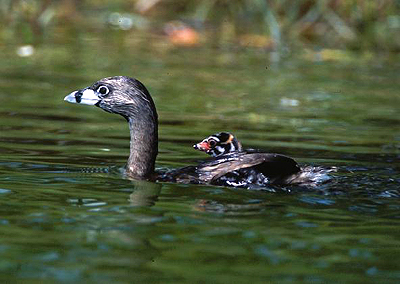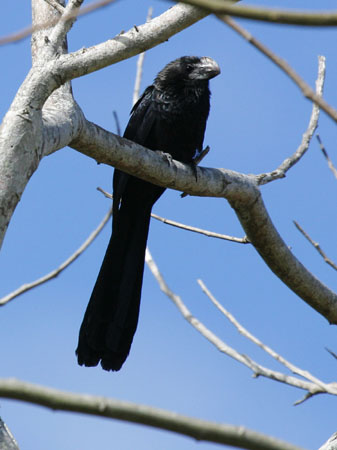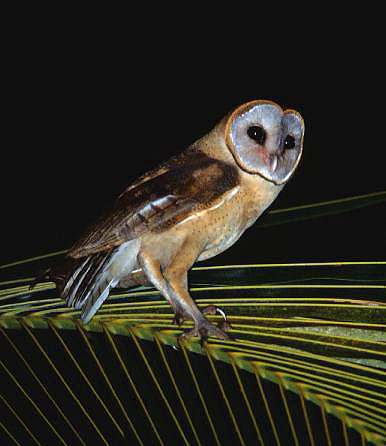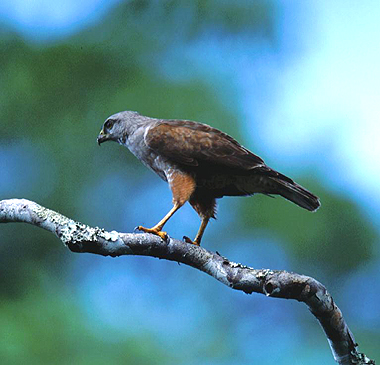 (photo by Eladio Fernandez).
(photo by Eladio Fernandez).
Prepared by Steve & Sandra Brauning ...Updated March 12, 2007
Please note that we do not have very good possibilities to provide guide services out East. It is too far for us to go for day trips, and it is not the best place for birding anyway (if we are going to do any extended trip, it would be to the Southwest(Bahoruco) - see that page please!!!) Please contact us a few months ahead of time to see if we can arrange something, but we cannot promise anything. However, we can provide the following information for the brave birder to use to venture out on his/her own.
1. Rio Cumayasa and Rio Soco Southeastern coast, between San Pedro and La Romana.
- around highway bridges, up and down; also upland at Ramon Santana/Cochoprimo area - semi-humid forest, transition forest, mangroves, canyon, swamp, salt marsh, beach, river mouth, etc.
This area is accessible as a day trip from Santo Domingo and/or areas in the East (San Pedro, La Romana, Bavaro, Higuey, Punta Cana). There are plenty of places to stay all through this area, since it is a tourist region. One would need just a regular car.
The Cumayasa canyon is located on the main coastal highway about 15KM west of La Romana. There is a crossroads just west of the bridge, at the top of the hill. Turning north onto the gravel road, one can drive down into the canyon to the river edge (caution on the windy gravel road). You can hike north along the river bed for at least 2 hours. It is rough terrain, sometimes flooded, and no real "trails". Just follow the river(which during the dry season is little more than a series of pools). This area has some of the uncommon forest birds like the Antillean Piculet, Greater Antillean Bullfinch, Loggerhead Kingbird, Broad-billed Tody, Black-whiskered Vireo, and so on(see list below). At one point you will reach a section with fairly steep cliffs on the sides: Red-tailed Hawks have been known to nest here.
Turning south of the highway at Cumayasa is Rancho Cumayasa, with a small restaurant, cabins, horseback riding, kayaks. It is a little messed up with the new bridge construction. There are Common Moorhens and possible other water birds down there.
Another attraction in the area is the "Cueva de Maravillas", a cave that the National Parks administers. It is along the main highway, a short distance west of the Cumayasa river, before the Soco river.
Next stop heading west is Boca de Soco, a town at the mouth of the Soco river. Turn south into town, and head to the river to look for water birds at the river mouth and around the mangroves(some disturbance there due to port construction). You can also head north along to river on a dirt road ito some pasture land.
Next area is Ramon Santana/Cochoprimo, for dry scrub forest and small patches of wetlands. Most common and some more scarce birds are there(BB Tody, Black-whiskered Vireo, Antillean Mango, Greater Antillean Grackle, Stolid Flycatcher, and so forth. Water birds, like Common Moorhens, Least Bittern
 (photo by Eladio Fernandez).
(photo by Eladio Fernandez).
and Limpkin are possible. Possible Rails: Black and Spotted.
This area is best reached by turning north on the new bypass highway just east of San Pedro, then turning east (right)on the old highway that crosses the new highway near the old sugar mill and railway crossing. That will take you through the town on Ramon Santana; keep heading out of town, on the dirt road until you see a right turn with a large girder bridge: turn there (this is the Soco river again). The next 2 KM or so has patchy woodlands and wetlands. When leaving this area, head back the same way.
This whole excursion would take a whole day, starting quite early (dawn) at Cumayasa, ending late afternoon in Ramon Santana.
The following list is not detailed: most of the birds are common all over the area, given appropriate habitat. Otherwise the spp. have notes.
Least Grebe
Pie-billed Grebe
 (photo by Eladio Fernandez).
(photo by Eladio Fernandez).
Brown Pelican
Magnificent Frigatebird
Green Heron
Snowy Egret
Great Egret
Little Blue Heron
Great Blue Heron
Least Bittern -Cochoprimo wetlands
Cattle Egret
Yellow-crowned Night-Heron
Limpkin -Cochoprimo wetlands
Red-tailed Hawk - Cumayasa canyon
American Kestrel
Merlin (Migratory -M)
Peregrine Falcon -M
Osprey -M
Turkey Vulture
Helmeted Guinea Fowl (I)
Northern Bobwhite (I)
Common Moorhen
Solitary Sandpiper -M
Spotted Sandpiper -M
Black-bellied Plover -M
Killdeer -M
Willet -M
Ruddy Turnstone -M
Black-necked Stilt
Least Tern ?
Royal Tern
Laughing Gull - Boca de Soco, uncommon
Ashy-faced Owl - Cochoprimo area (nighttime)
Zenaida Dove -Uncommon
Mourning Dove
Common Ground Dove
White-winged Dove
Mangrove Cuckoo
Hispaniolan Lizard-Cuckoo
Smooth-billed Ani
 (photo by Eladio Fernandez).
(photo by Eladio Fernandez).
Antillean Nighthawk
Antillean Palm Swift
Antillean Mango
Vervain Hummingbird
Broad-billed Tody
Hisp. Woodpecker
Antillean Piculet - Cumayasa Canyon, Soco river, Parque del Este -uncommon
Belted Kingfisher - M
Gray Kingbird
Loggerhead Kingbird Cumayasa Canyon - uncommon
Stolid Flycatcher - Cumayasa canyon
Caribbean Martin
Barn Swallow M
Bank Swallow M
Cave Swallow
Northern Mockingbird
Red-legged Thrush
Palm Chat
Black-whiskered Vireo
Flat-billed Vireo --- Rare, unverified in Cumayasa since the 1960's
Yellow Warbler("Golden" family subspecies) Boca de Soco
Northern Parula M
 (photo from Internet).
(photo from Internet).
Cape May Warbler M
Yellow-rumped Warbler M
Black-throated Blue Warbler M pass-through migrant
Prairie Warbler M
Palm Warbler M
Blackpoll Warbler M pass-through migrant
Black & White Warbler M
American Redstart M
Ovenbird M
Louisiana Waterthrush M
Northern Waterthrush M
Common Yellowthroat M
Bananaquit
Black-crowned Palm Tanager
Yellow-faced Grassquit
 (photo by Cursorius).
(photo by Cursorius).
Greater Antillean Bullfinch Cumayasa canyon
Greater Antillean Grackle Boca de Soco & Cochoprimo
Village Weaver (I)
Nutmeg Mannikin (I)
Chestnut Mannikin(I)
The trick here is to scout out during the day, where sugar cane is being cut. Then one must return to those fresh-cut cane fields and use headlights, spotlights and playback tapes, track down the night birds that congregate to feed on small creatures stirred up. This is possible mainly from about January through July. The rest of the year it is hit or miss.
Limpkin (in wetland, ravines)
Barn Owl
Ashy-faced Owl
endemic, found in wooded areas.
 (photo by Eladio Fernandez).
(photo by Eladio Fernandez).
Short-eared Owl
Double-striped Thick-Knee.
 (photo by Eladio Fernandez).
(photo by Eladio Fernandez).
Black Rail(?) Cochoprimo wetlands
Spotted rail (?) Cochoprimo wetlands
This area requires more preparation: preferably a pre-arranged tour with a guide (see our other pages about "Why/How to birdwatch..."). National Park entrance and movement usually requires prior permission, and a boat is needed to get to Saona.
One can get to into the fringes of the park at "Guaraguao", by car and on foot, by heading east along the coastal road from the town of Bayahibe. But there is a lot of tourism develpment there, besides that fact that the national park may require permits to get in.
Many of the above spp. plus:
Brown Booby -Open ocean
Greater Flamingo - Far point of Saona Isl. although colony may be extirpated
Brown Noddy -Open ocean
Caspian Tern
Great Black-backed Gull - Saona Isl.
American Oystercatcher - Saona Isl.
Plain Pigeon Inland, national park
White-crowned Pigeon - Mangroves
Ruddy Quail-Dove - Parque del Este
Hispaniolan Parrot - Bayahibe & Boca de Yuma entrances to National park
Yellow-billed Cuckoo
Northern Potoo - uncommon and HARD to find, Parque del Este
 (photo from Internet).
(photo from Internet).
White-necked Crow - Occasional in Bayahibe, common on Saona
Cave Swallow
Pearly-eyed Thrasher Not substantiated
Greater Antillean Oriole - Coast, forest, Saona Isl.
Note: a highlight would be the "Mata de Pajaro" Frigatebird colony, in the area called "EL Caldero", accessible only by boat and only with previous permission from the National Parks. Hundreds of nesting "Man o' War" birds there, esp. Feb. and March.
4. Bavaro beach area Wetlands and lagoons near hotels:
The problem here is that some of the wetlands and lagoons are INSIDE hotel properties and not accessible to the public. However, the Laguna Bavaro is accesible but limited to observations from the densely vegetated edge.
The list should include many of the above plus:
Ruddy Duck
Masked Duck
White-cheeked Pintail
Caribbean Coot
Purple Galinule
Northern Jacana
 Ridgway's Hawk ("Gavilan") - Endemic
Ridgway's Hawk ("Gavilan") - Endemic
photo by Eladio Fernandez).
This area is accessible from the town of Sabana de la Mar: the Caņo Hondo eco-lodge is several miles west of the town, on the edge of the National Park. Then excursions on boat can be arranged to go along the coast, and to the "Los Naranjos" area, for the Ridgway's.
The list would include most of the above birds plus:
Hispaniolan Pewee (in remote wooded areas)
Several islands along the coast with nesting colonies of Black-crowned Night Herons, along with Brown Boobies, Brown Pelicans, Mag. Frigatebirds, Great Egrets, Snowy Egrets, etc.
The other area for Ridgway's Hawk is Los Limones, inland on the western edge of the national park, accessed through the town of Sabana Grande de Boya. It's a rough, long ride, but there is a Peregrine Fund nest monitoring project going on. E-mail Lance Woolaver - lancewoolaver@hotmail.com - he will be able to direct you and arrange access.
Return to Table of Contents
Last Updated March 12, 2007 by Steve Brauning